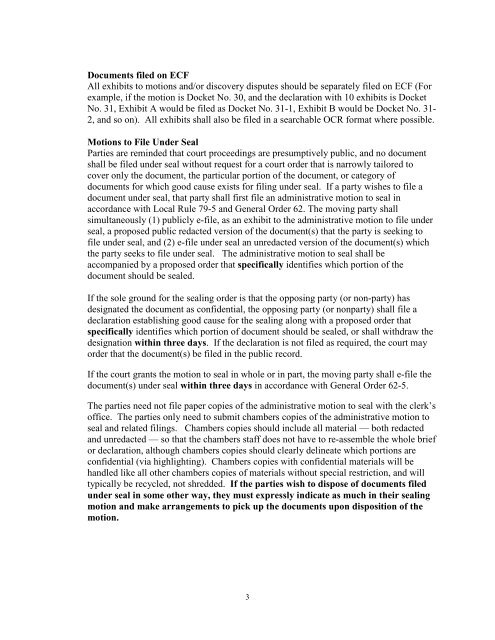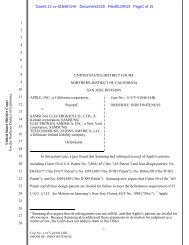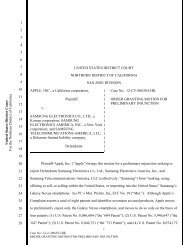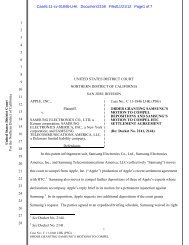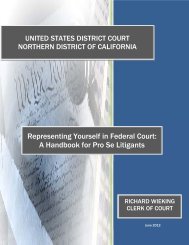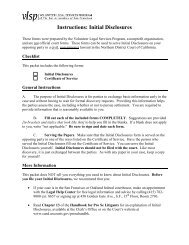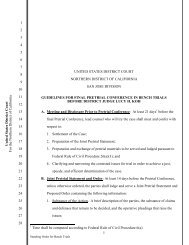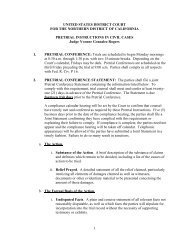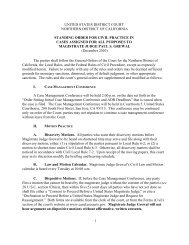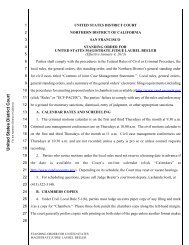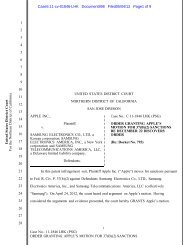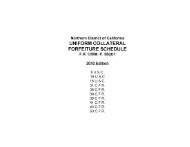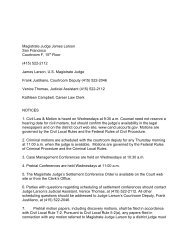Magistrate Judge Corley's Civil Standing Order - United States ...
Magistrate Judge Corley's Civil Standing Order - United States ...
Magistrate Judge Corley's Civil Standing Order - United States ...
You also want an ePaper? Increase the reach of your titles
YUMPU automatically turns print PDFs into web optimized ePapers that Google loves.
Documents filed on ECF<br />
All exhibits to motions and/or discovery disputes should be separately filed on ECF (For<br />
example, if the motion is Docket No. 30, and the declaration with 10 exhibits is Docket<br />
No. 31, Exhibit A would be filed as Docket No. 31-1, Exhibit B would be Docket No. 31-<br />
2, and so on). All exhibits shall also be filed in a searchable OCR format where possible.<br />
Motions to File Under Seal<br />
Parties are reminded that court proceedings are presumptively public, and no document<br />
shall be filed under seal without request for a court order that is narrowly tailored to<br />
cover only the document, the particular portion of the document, or category of<br />
documents for which good cause exists for filing under seal. If a party wishes to file a<br />
document under seal, that party shall first file an administrative motion to seal in<br />
accordance with Local Rule 79-5 and General <strong>Order</strong> 62. The moving party shall<br />
simultaneously (1) publicly e-file, as an exhibit to the administrative motion to file under<br />
seal, a proposed public redacted version of the document(s) that the party is seeking to<br />
file under seal, and (2) e-file under seal an unredacted version of the document(s) which<br />
the party seeks to file under seal. The administrative motion to seal shall be<br />
accompanied by a proposed order that specifically identifies which portion of the<br />
document should be sealed.<br />
If the sole ground for the sealing order is that the opposing party (or non-party) has<br />
designated the document as confidential, the opposing party (or nonparty) shall file a<br />
declaration establishing good cause for the sealing along with a proposed order that<br />
specifically identifies which portion of document should be sealed, or shall withdraw the<br />
designation within three days. If the declaration is not filed as required, the court may<br />
order that the document(s) be filed in the public record.<br />
If the court grants the motion to seal in whole or in part, the moving party shall e-file the<br />
document(s) under seal within three days in accordance with General <strong>Order</strong> 62-5.<br />
The parties need not file paper copies of the administrative motion to seal with the clerk’s<br />
office. The parties only need to submit chambers copies of the administrative motion to<br />
seal and related filings. Chambers copies should include all material — both redacted<br />
and unredacted — so that the chambers staff does not have to re-assemble the whole brief<br />
or declaration, although chambers copies should clearly delineate which portions are<br />
confidential (via highlighting). Chambers copies with confidential materials will be<br />
handled like all other chambers copies of materials without special restriction, and will<br />
typically be recycled, not shredded. If the parties wish to dispose of documents filed<br />
under seal in some other way, they must expressly indicate as much in their sealing<br />
motion and make arrangements to pick up the documents upon disposition of the<br />
motion.<br />
3


